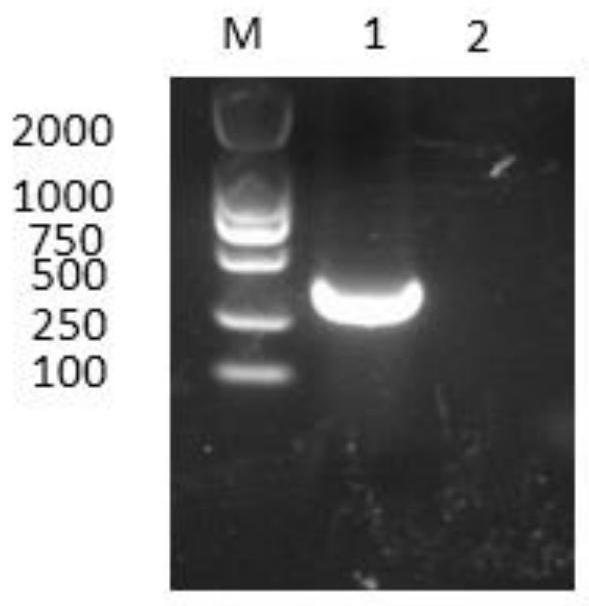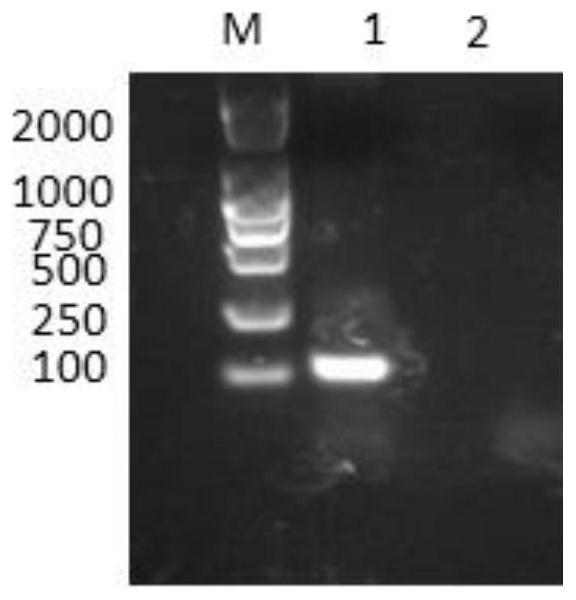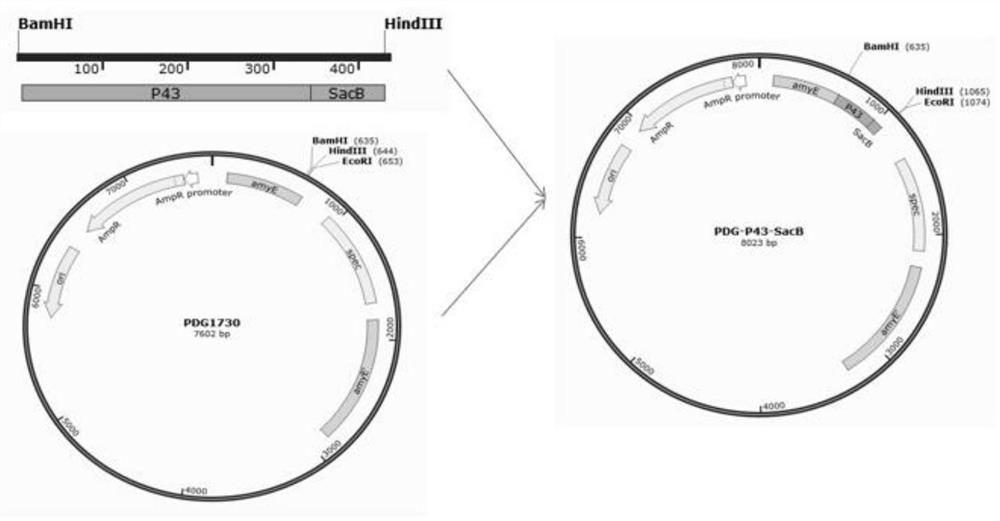A recombinant Bacillus subtilis engineering bacterium producing pig glutamine synthetase, its construction method and its application
A technology of Bacillus subtilis and porcine glutamine, applied in the field of animal genetic engineering, can solve problems such as easy decomposition, instability, and limited application
- Summary
- Abstract
- Description
- Claims
- Application Information
AI Technical Summary
Problems solved by technology
Method used
Image
Examples
Embodiment 1
[0047] Example 1 Construction of recombinant Bacillus subtilis engineering bacteria producing pig glutamine synthetase
[0048] In this example, the starting plasmid PDG1730 and wild-type Bacillus subtilis WB800 were donated by Professor Ming Sun of the School of Life Science and Technology of Huazhong Agricultural University, and Escherichia coli DH5α was purchased from Beijing Quanshijin Biotechnology Co., Ltd.
[0049] S1: Design primers for P43 gene and SacB gene respectively, and amplify to obtain corresponding gene fragments.
[0050] According to the fragment sequence of the P43 gene (promoter) in NCBI (accession number NCBI-Gene ID: EF473728.1) and the sequence of the signal peptide SacB gene fragment (accession number NCBI-Gene ID: MH614588.1), the primers were designed as follows:
[0051] Forward primer P43-F: CGggatccgagctcagctttatgagtgg, see SEQ ID NO: 1;
[0052] Reverse primer P43-R: GCAAACTTTTTGATGTTCATgtgtacattcctctcttacc, see SEQ ID NO: 2;
[0053] Forward ...
Embodiment 2
[0082] Example 2 Secretion and expression of pGS by gene recombinant Bacillus subtilis
[0083] The verified correct recombinant Bacillus subtilis strain RBs-GS will be fermented.
[0084] The specific steps are: pick a single clone and inoculate it in 5ml of LB medium, activate it at 37°C and 200r / min for 12-24h; take the activated bacterial solution and inoculate it in 50mL In the LB medium of 37°C, cultivated at 200r / min for 2-14h, take the fermentation suspension of the recombinant bacteria and the fermentation suspension of the control bacteria (ie wild-type Bacillus subtilis WB800), and use Shanghai Enzyme The GSElisa assay kit produced by Science and Technology Co., Ltd. detects the content and activity of the fermented bacteria suspension (i.e., the pGS obtained) according to the kit operation manual, and obtains the following results: Figure 9 with Figure 10 The results shown.
Embodiment 3
[0085] Example 3 The protective effect of recombinant Bacillus subtilis RBs-GS on the intestinal tract of offspring rats
[0086] The recombinant Bacillus subtilis strain RBs-GS of the present invention is used as a probiotic preparation, and the preparation method is as follows: RBs-GS is cultured in a shaker at 37° C. and 200 r / min for 6 hours to obtain a fermented bacterial suspension that is a probiotic preparation. The purpose of feeding weaned rats with damaged intestines is to verify the ability of the recombinant Bacillus subtilis RBs-GS of the present invention to repair the damaged intestines of weaned rats at the animal level.
[0087] Test grouping
[0088] For the animal experiment, 200 weaned pups with similar age and weight at 19-21 days were selected and divided into 10 groups, with 3 repetitions in each group. The test period was 15 days. The basic diet was provided by the Animal Experiment Center of Huazhong Agricultural University as a routine The basal die...
PUM
 Login to View More
Login to View More Abstract
Description
Claims
Application Information
 Login to View More
Login to View More - R&D
- Intellectual Property
- Life Sciences
- Materials
- Tech Scout
- Unparalleled Data Quality
- Higher Quality Content
- 60% Fewer Hallucinations
Browse by: Latest US Patents, China's latest patents, Technical Efficacy Thesaurus, Application Domain, Technology Topic, Popular Technical Reports.
© 2025 PatSnap. All rights reserved.Legal|Privacy policy|Modern Slavery Act Transparency Statement|Sitemap|About US| Contact US: help@patsnap.com



